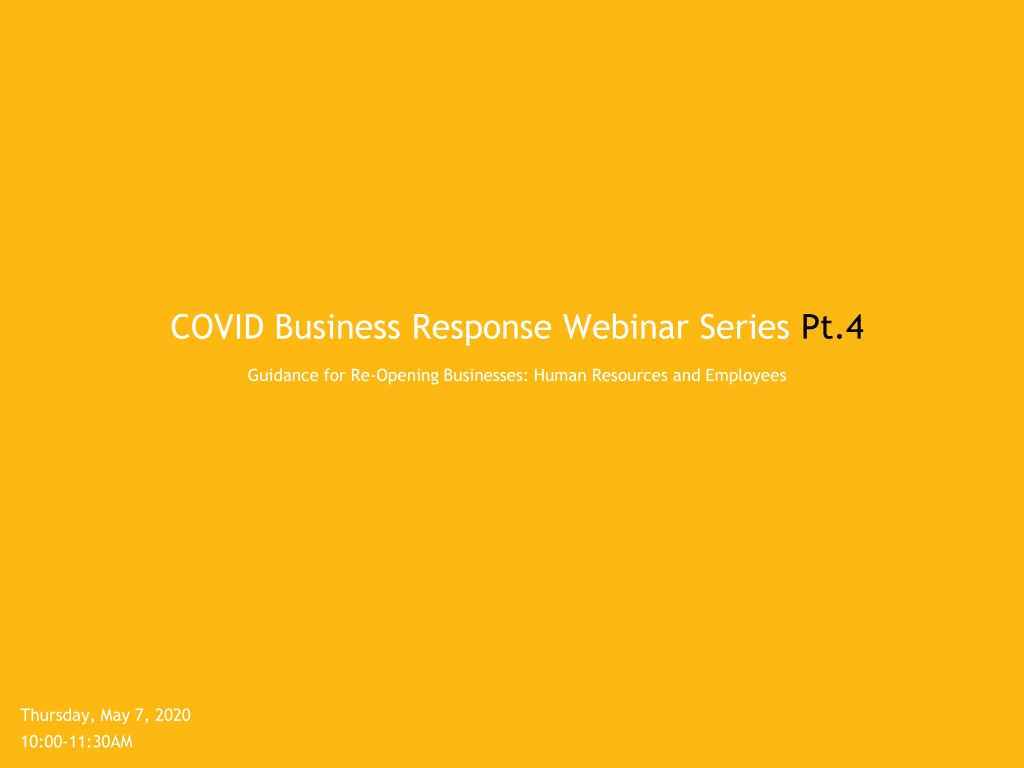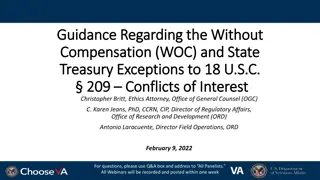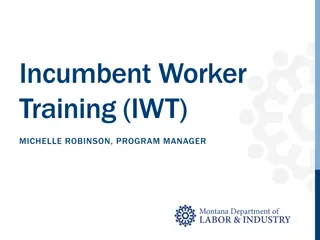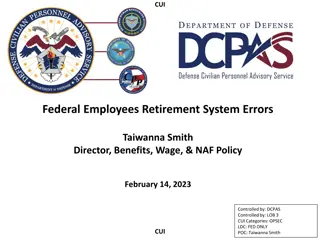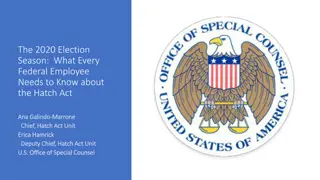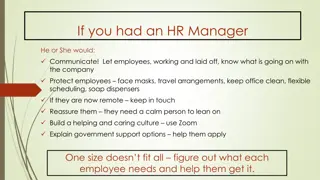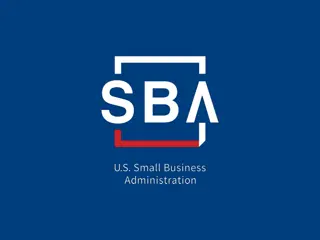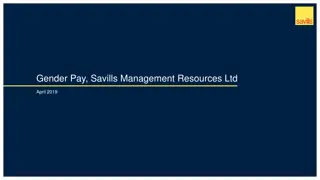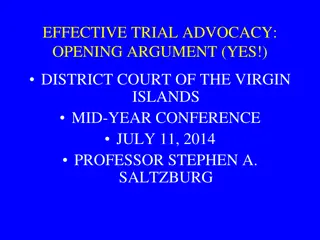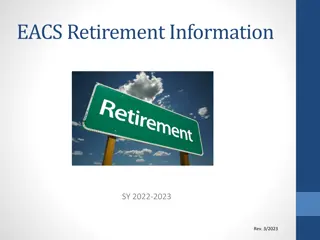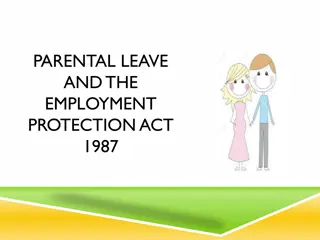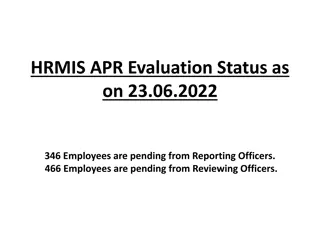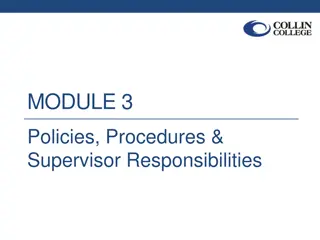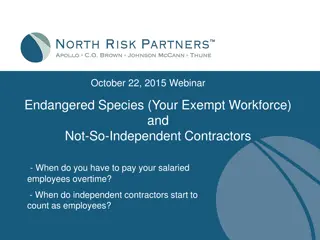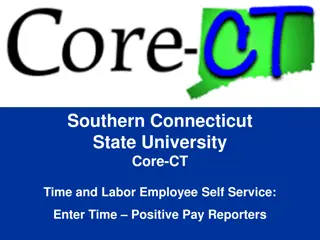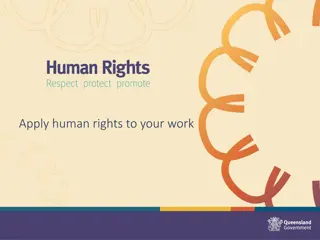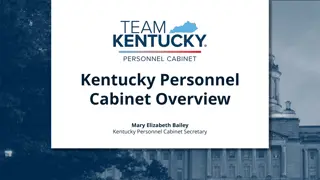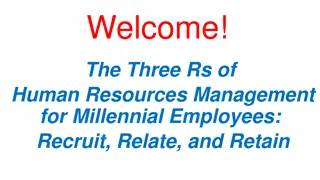Guidance for Re-Opening Businesses: Human Resources & Employees
The webinar series discusses important considerations for businesses preparing to reopen post-coronavirus outbreak, focusing on human resources, liability risks, and policies related to COVID-19. Insights are shared on updating handbook policies, documentation for employee payments, and the potential impact of unchecked litigation on businesses.
Uploaded on Oct 05, 2024 | 0 Views
Download Presentation

Please find below an Image/Link to download the presentation.
The content on the website is provided AS IS for your information and personal use only. It may not be sold, licensed, or shared on other websites without obtaining consent from the author. Download presentation by click this link. If you encounter any issues during the download, it is possible that the publisher has removed the file from their server.
E N D
Presentation Transcript
COVID Business Response Webinar Series Pt.4 Guidance for Re-Opening Businesses: Human Resources and Employees Thursday, May 7, 2020 10:00-11:30AM
Preparing Your Business to Reopen After Coronavirus Outbreak Ed Kowalski HR Director
Todays Presentation Will Cover Re-Opening the Business: What to Consider Business Owners Liability Risks HR COVID Related Liabilities Questions 3
Unchecked litigation for any injury linked to the coronavirus would significantly increase uncertainty for small businesses, nonprofits, corporations, universities, transit systems, shopping malls and retirement villages. All of them are trying to protect their people, serve the public, and preserve their organizations. Dealing with urgent needs, scarce information, and often dwindling resources, they make the best decisions they can. And now these businesses all face the threat of litigation for not only present decisions but even actions before the threat of coronavirus was evident. This is wildly counterproductive and it will be expensive . What Won t Cure Corona: Lawsuits Wall Street Journal April 21, 2020 Evan Greenburg, CEO Chubb Insurance
Updating Handbook Policies Review policies to ensure compliance with newly enacted laws, such as state and local paid sick leave laws based on COVID-19 related absences Review or revise remote and telework policies Create policies for when an employee becomes symptomatic, tests positive, or is potentially exposed to COVID-19 Policy should inform employees of measures to ensure their safety Write policies regarding containment measures: temperature monitoring, handwashing, face mask usage If employers are implementing COVID-19 testing, detail policies regarding frequency, location, testing, HIPAA protections, etc
Why Documentation is SO Important When paying employees ePSL or EFLMA time, make sure to code the pay in your time card system. The FFCRA provides that employers may recapture benefits paid towards emergency paid sick leave or expanded FMLA protections through a refundable tax credit, applied against the employer s Federal Insurance Contribution Act (or FICA ) taxes. The extent of these credits aligns with the amounts to be paid eligible employees. In other words, for those employees eligible to receive emergency paid sick leave benefits up to $511 per day, the employer may claim a credit up to $511 per employee per day, and for those employees eligible to receive emergency paid sick leave or expanded FMLA benefits up to $200 per day, the employer may claim a credit up to $200 per employee per day. These credits can be claimed by employers each quarter.
When Can I Resume Operations? New York State: Currently, stay-at-home orders are set to expire on May 15 Other States: Comply with state and local directives
Should I Resume Operations Once the Order Ends? The CDC recommends not reopening unless you can answer YES to ALL of the following questions essential critical workers)? Are you in a community no longer requiring significant mitigation (or restricting operations to designated Will you be able to limit non-essential employees to those from the local geographic area? Do you have protective measures for employees at higher risk? (e.g., teleworking, tasks that minimize contact?)
What Safeguards Should we Implement? Use of healthy hygiene practices Intensified cleaning, disinfection, and ventilation Social distancing Telework and cancellation of non-essential travel Seating distance of at least 6 feet and staggered gathering (starting/closing) times Restricted use of any shared items or spaces Training all staff in all of the safety actions
What Monitoring Protocols Should We Have? Sick employees should stay home! Establish routine, daily employee health checks Monitor absenteeism and have flexible time off policies Have an action plan if an employee tests positive/ presumptive positive for COVID-19 Create and test emergency communication channels for employees Establish communications with state and local authorities Be prepared to close quickly if needed to based on applicable guidelines
Which Employees Should Return First? Base decisions on who should return to work on the following criterion: Business need Compliance with ongoing restrictions regarding limitations of operations to essential business Compliance with health precautions such as social distancing DOCUMENT the selection process to provide evidence of non-discriminatory selection criteria
Reinstatement for Employers with Fewer than 25 Employees May refuse to return employees to their same position if the employee took leave to care for their child whose school/ child care provider is closed/ unavailable and all four of the following conditions exist: Employee s position no longer exists due to economic or operating conditions that affect employment due to COVID-19 related reasons during leave; and Employer makes reasonable efforts to restore the employee to the same or an equivalent position; Employer makes reasonable efforts to contact the employee if an equivalent position becomes available; and Employer continues to make reasonable efforts to contact employee for one year beginning on the earlier of the Date the leave concludes or the date 12 weeks after leave began
Hiring Considerations Consider virtual interviews and onboarding Employers may screen applicants for symptoms after making a conditional job offer Pre-employment medical exams, such as taking temperature, are permitted Employers may delay start dates for new hires who have symptoms of COVID-19 Employers may not postpone start dates or withdraw job offers for individuals at higher risk for COVID-19
Form I-9 Update: Flexibility for In-Person Rules Employers may inspect section 2 documents remotely (via email, webcam, fax, etc) Obtain, inspect, and retain copies of the document within 3 days On Form I-9, write COVID-19 in Additional Information section
Form I-9 Update: Flexibility for In-Person Rules Once normal operations resume, review original documents within 3 business days and write documents physically examined with date of inspection in Additional Info field
What Employee Guidelines Will be Required? Social distancing rules Communicate these rules electronically or in hardcopy at workstations and common areas Employees should acknowledge receipt of rules Train supervisors on how to enforce social distancing rules Employers may require employees to wash hands at specified frequencies, following recommended practice
How to Social Distance in the Workplace Comply with federal, state and local directives on social distancing as workplaces reopen Stagger work hours/ alternate days of work for different groups, shifts or teams Evaluate layouts consider making stairways or hallways one-way Use plexiglass shields, tables or other barriers Develop protocols to avoid crowding in elevators Close or modify certain common areas, such as lunch rooms and time clock stations Implement rules to limit sharing equipment and supplies Change latch-based door handles to use of an electric eye or with a push of the door or a button or push pad Rethink customer service delivery methods
COVID 19 Tests in the Workplace The EEOC has approved use of the following screening mechanisms if completed in a manner that is consistent with the EEOC guidance including confidentiality of medical information: Screening for Symptoms: Employers may ask employees entering the workplace about any symptoms identified by public health authorities as associated with COVID-19. For instance, employers may ask employees about fever, cough, shortness of breath, loss of smell or taste, as well as gastrointestinal problems such as nausea, diarrhea and vomiting. Employers must maintain the confidentiality of any notes or documentation related to this screening. COVID-19 Tests: Employers may administer a COVID-19 test (designed to detect the presence of the COVID-19 virus) before permitting employees to enter the workplace without running afoul of the Americans with Disabilities Act. Employers considering this course of action should review guidance from the U.S. Food and Drug Administration concerning safe and accurate testing. Temperature Checks: Employers may require all employees to have a daily temperature check before entering the workplace and may maintain a log of the results. Again, employers must maintain the confidentiality of this medical information. All medical information about a particular employee, including information relating to COVID-19, should be stored separately from the employee's personnel file, thereby limiting access to this confidential information. However, employers may store medical information related to COVID-19 in existing medical files and need not create a new file system solely for this information.
COVID 19 in the Workplace New CDC Recommendations The CDC has learned that asymptomatic and pre-symptomatic individuals can be highly contagious and spread the disease when interacting in close proximity for example, speaking, coughing, or sneezing even if those people are not exhibiting symptoms. [1] Face coverings may capture droplets and minimize some exposures to the virus.[2] Accordingly, the CDC advises the use of simple cloth face coverings to slow the spread of the virus and help people who may have the virus and do not know it from transmitting it to others. [3]Further, the CDC recommends wearing cloth face coverings in public settings where other social distancing measures are difficult to maintain (e.g., grocery stores and pharmacies) especially in areas of significant community-based transmission. These cloth coverings are not surgical masks or filtering face-piece respirators which are critical supplies that the CDC recommends be limited to use by healthcare workers.
COVID 19 in the Workplace Employer Safety Challenges from Face masks Under the Occupational Safety and Health Act, employers have a general duty to provide a workplace free from recognized hazards likely to cause serious physical harm or death. As we have consistently recommended, employers can help ensure compliance with their legal duties regarding COVID-19 by carefully tracking the CDC recommendations, communicating hazards and agency recommendations to employees, and training employees on safety measures such as including PPE. ADA Liabilities Employees with compromised immune systems and respiratory conditions may be at heightened risk from community transmission of COVID-19. In workplaces that have not permitted voluntary use of face masks, these employees may request to use face masks as a reasonable accommodation. Employers will be required to engage in a robust interactive process and come to a determination as to whether a face mask is a reasonable accommodation or cannot be allowed, for example, if the face mask presents a direct threat due to the health of that employee or an entanglement hazard.
COVID 19 in the Workplace Whistleblower / Retaliation Liabilities Employees may bring claims for retaliation under Section 11(c) of the Occupational Safety and Health Act if they are not allowed to wear a face mask or are sent home for refusal to wear a company- provided face mask. To state a prima facie case for OSHA retaliation, an employee must establish (1) a protected activity, such as making internal safety complaints, complaining to OSHA, or refusing to perform unsafe tasks, (2) an adverse employment action, and (3) causal connection between the two. The Act gives employees the right to file a whistleblower claim with OSHA within 30 days of the adverse employment action. The agency will then conduct an investigation of the claim; there is no private cause of action under the Act. As to protected activity, employees may complain if they are not permitted to wear face masks or may refuse to perform functions where they work in close contact with others without face masks. Employees generally do not have the right to walk off the job or refuse to attend work entirely on account of a safety concern once the employer demonstrates that it has a program to protect the employee against the hazard. The employee may only refuse to perform specific tasks for which the employee has an objectively reasonable safety concern that the employer has not yet addressed. Accordingly, employers implementing face mask policies must be aware of these potential retaliation issues.
What if an Employee Does Not Wear Their PPE? If an hourly non- exempt employee comes to work without PPE May send home for the remainder of the day without pay May provide him/her with PPE May send them home unpaid to retrieve PPE If a salaried exempt employee comes to work without PPE May send them home for the day or to retrieve PPE, but cannot dock pay on hourly or daily basis If an Employee repeatedly comes to work without PPE Document behavior and use internal disciplinary system
Can an Employer Screen an Employees Health? Employers can measure employees body temperature Notify employees in advance, and advise it is to monitor for COVID-19 symptoms and not to determine if the employee has any other illness, impairment, or disability Notify employees that the screening is not intended to be a clinical diagnosis Create a form to record information and protect information under ADA confidentiality requirements More screening options may become available and the government should issue additional guidance regarding such options
If an Employee Refuses to Consent to Testing If the policy is that an employee cannot work onsite without submitting to health testing, the employer can bar the employee from work (without pay for non-exempt personnel and also for exempt personnel if the absence from work is for an entire work day)
How Can We Protect Employees Conducting Screenings? Use physical barriers and/ or PPE, which may include face shields Train employees in how to conduct screenings Additional information can be found at OSHA s website If using a third-party vendor, confirm that vendors have a protocol in place to minimize exposure risk
An Employee has a Temperature or Other Symptoms If an employee has a temperature, confirm with a second test in a confidential manner Consider any explanation the employee might have Send the employee home if the temperature is greater than 100.4 Consider how to treat the absence under sick-leave/PTO policy and entitlements to other leave, such as leave provided by the CARES ACT.
What if the Employee Needs COVID Leave after We Re-Open? If the employee becomes ill after re-opening, they still may be eligible for Federal Emergency Paid Sick Leave or other state or local leave or paid leave entitlements. If the employee needs to care for someone who is ill or has to take care of a dependent whose school is closed, they may be eligible for Federal Emergency Paid Sick Leave and Emergency FMLA
Can We Screen Visitors to the Workplace? Consider not allowing or limiting visitors to the worksite It is acceptable to screen visitors before entering a facility Communicate by email or other means to regular visitors, suppliers, and delivery companies explaining the COVID-19 management policy
Can Employees Continue to Work Remotely? Yes OSHA recommends flexible worksites to increase physical distance among employees Many employees may request to continue working remotely Consider in advance how to handle such requests, taking into account the Americans with Disabilities Act s (ADA) reasonable accommodation requirements for individuals with disabilities
Working from Home What to Consider Making the Decision Review existing resources, applicable policies, and customer agreements to determine if remote work is feasible, prudent, and contractually permissible Have a plan for resources, communications, expense reimbursements, etc Review insurance policies (benefits, WC, cyber) to ensure coverage Stay on top of development as plans may need to be changed Confirm IT infrastructure can support remote work Communicate clearly and consistently Ensure critical lines of communication btw management are open In the course of developing communications to employees, examine existing policies closely, such as confidentiality, written information security programs, business continuity, BYOD, etc A localized approach may be warranted based on local conditions Provide employees system access instructions and where to go for help Be understanding and solution-oriented Ensure data privacy and security
Work from Home Regulations & Policies Make sure to comply with all applicable federal, state, and local wage laws Pay hourly employees for waiting time or on-call time (is the employee engaged to wait or waiting to be engaged ) Salary exempt employees must be paid for full days in which they engage in work
Covid-19 Cyber Insurance: Do you have the right coverage? Most organizations are now requiring that their employees work from home with the ongoing novel coronavirus disease (COVID-19) pandemic. However, in the event of a breach or other incident, there may be limitations in your cyber liability insurance policy based upon the type of hardware being used. As with all contracts, whether there is coverage or not will depend on the specific terms and conditions of the insurance policy itself. What Cyber Insurance coverage do you have?
Potential Claims by Customers, Vendors and Other Third Parties Premise Liability Statutes Create duty to make your property safe for customers, vendors and others who you allow to enter your business. In the context of COVID 19, premises liability claims can be asserted if business owners fail to properly protect their visitors from COVID 19 exposure, fail to warn about risks such as those created if an employee has been infected or fail to take steps to identify those who might have contracted COVID-19 who pose a risk to other visitors. Negligence Based Claims Can arise where a business owner puts a visitor at risk or fails to reasonable act when the risk of harm was reasonably foreseeable. State Consumer Protections Acts and Misleading Advertising Claims Claims could arise from statements made by businesses. If a business is advertising that it is taking precautions to protect customers, care must be taken to be factually accurate.
Potential HR Related COVID Claims OSHA: Identify internal and external potential sources of exposure to workers. Develop policies and procedures for prompt identification and isolation of employees who self- report symptoms and illnesses. FLSA: Clearly identify expectations of hourly employees who temporarily work from home. For example: Is there a cap on hours worked? How should they record their time? What are expectations of their productivity? Also, remind employees that working from home is not a substitute for leave and how to request paid time off and/or FMLA consistent with your policies when they are unable to work from home due to illness or for personal reasons. Employers should determine whether to extend, modify or adjust paid time off policies to provide additional paid time benefits to employees on a temporary basis. Title VII: There is potential for racial and national origin profiling and comments among employees, particularly towards those individuals perceived or believed to be from countries where COVID-19 originated. It is important to remind employees not to engage in inappropriate discussions or rumors about coworkers and to restate your expectations for maintaining a respectful workplace.
Potential HR Related COVID Claims ADA: Determine the essential functions of job positions, whether they are conducive to working from home. Remind key managers of the dangers of concluding an employee who exhibits common symptoms has COVID-19 from a regarded as disabled stand point. FMLA: Review possible scenarios that would require unexpected employee leaves and whether the leave is Family and Medical Leave Act (FMLA) and/or Wisconsin Family and Medical Leave Act (WFMLA) covered. For example, while staying home with a sick child or spouse may be FMLA/WFMLA covered, a school closing unrelated to an illness of a covered family member likely is not covered. Prepare FMLA/WFMLA certifications forms now and/or touch base with your FMLA/WFMLA provider to ensure they are ready for an influx in requests. Workers Compensation:Consult with your workers compensation insurance administrator to determine when COVID-19 is a work-related injury that needs to be reported. To be reportable to WC, the disease must be occupational, meaning it arose out of and was in the course of employment. The illness or disease must arise out of or be caused by conditions peculiar to the work and creates a risk of contracting the disease in a greater degree and in a different manner than in the public generally. Unless employees are exposed to the virus by the nature of their profession (health care workers, first responders, etc), COVID cases will most likely not be covered by WC
Steps to Minimize Liability Risk Know the scope of your insurance coverage Follow Federal, State, County and City guidance on conducting business during this time. Training is important Review indemnification obligations and understand if those obligations are insured.
Webinar: 5.0 May 14, 2020 Thank You! Next Week s Topic: Latest Guidance on the Paycheck Protection Program with a Focus on Record Keeping to Ensure Loan Forgiveness May 14, 2020 10:00-11:30 AM Questions: Visit www.ocnyida.com or email swilson@the-accelerator.com.
